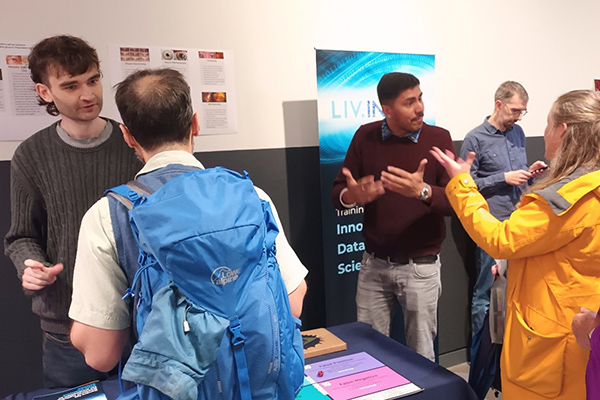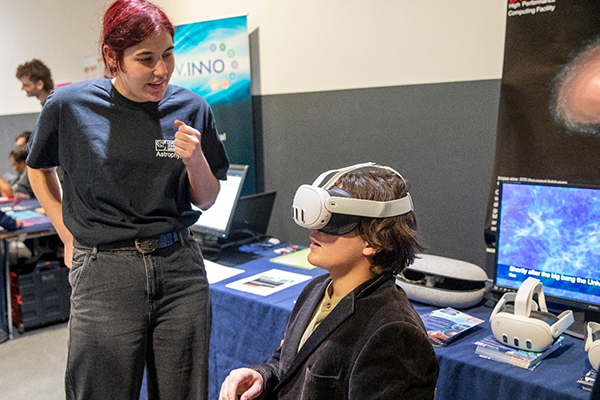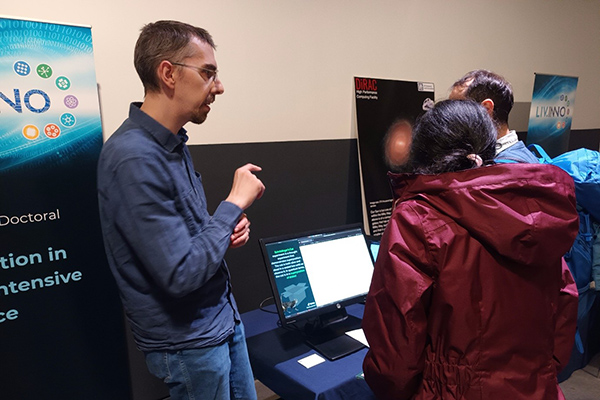Art forgery to astrophysics: LIV.INNO showcases data science at the British Science Festival

A team of LIV.INNO staff and students, including members of the QUASAR Group, have run an event to showcase the wide range of data science research that the centre undertakes at the British Science Festival on Sunday 14th September at the Museum of Liverpool. Over 2000 people came to visit the museum that day and many hundreds of them interacted with the fourteen researchers from LIV.INNO who were in attendance.

Rosie Bartlett demonstrating the VR experience to a visitor. Photo by Gavin Trafford and Gareth Jones, via British Science Association.
Visitors were able to use a VR headset to look around the Milky Way as if they were suspended in space and were able to observe areas of dark matter. Visitors of all ages had a great time taking part in this experience!
The DiRAC consortium kindly contributed some of the VR headsets for this activity. LIV.INNO has links to the DiRAC consortium through Professor Simon Hands who is LIV.INNO Partner Liaison Manager as well as Community Development Director for DiRAC.

Archie Hanlon and Saransh Malhotra talking to visitors about AI and Eyes. (Credit: LIV.INNO)
The AI and Eyes activity got another outing with LIV.INNO students Archie Hanlon and Saransh Malhotra, who is also a member of the QUASAR Group, talking to the visitors about how AI is used in detecting eye disease, and whether this can be done reliably. A game where you had to roll dice was used to show how sometimes the AI gets it wrong (but this also true of people as well). However, Al can analyse scans much faster than people can, so it is a useful tool to help in diagnosis. Archie and Saransh also spoke about how they use data science and AI in their own research into developing sensors for particle physics experiments and developing improved photocathodes.

David Schaich talking to visitors about Bell states. (Credit: LIV.INNO)
The uses of AI in the world of Art was represented by two separate activities delivered by LIV.INNO supervisor Pavel Buividovich and PhD student Ben Hind. Pavel was talking to visitors about how AI can be used in detecting art forgery, but also looking at how good AI was at making art forgeries. Visitors were shown several copies of the same picture. One by the original artist, one a copy by a human and the other an AI copy. Visitors had to work out which was which. While it was clear AI made some mistakes which humans would not AI was otherwise very good at forgery!
A related activity by Ben Hind looked at how AI can be used to classify street art. Ben had written an app for this event, with assistance from fellow LIV.INNO students Salma Louhaichy and Qiyuan Xu from the QUASAR Group, where visitors were given a set of street art pictures and asked which two they considered to be the most similar in style. Their answers were then compared with the answer AI gave for the same set of pictures. There were no right or wrong answers in this case, but it was interesting to see how well AI can be trained to think like a human.
The LIV.INNO team were joined at this British Science Festival event by some colleagues from the Computer Science Department who ran a series of activities about how algorithms work and be used to solve problems. These two activities had been joined by the organisers of the British Science Festival, and they worked well together to showcase the many uses of data science.
The activities offered by the LIV.INNO team were busy throughout the day, and all the researchers involved had many fruitful conversations with the people from a wide variety of backgrounds who attended this event. The activities produced will be used again at future outreach events for both LIV.INNO and other projects which the individual researchers are involved in.
QUASAR Group Project T.E.A.M. member and LIV.INNO Centre Manager Naomi Smith, who co-ordinated the inputs to the data science event said: ‘Seeing so many people interacting with such a wide range of LIV.INNO research was wonderful to see. The data science showcase highlighted the impact that the LIV.INNO CDT has in a way which was accessible to people from a wide variety of backgrounds.’
More information about the event can be found on www.livinno.org.